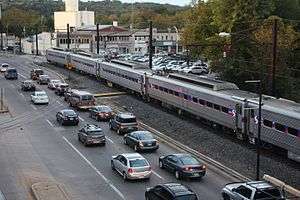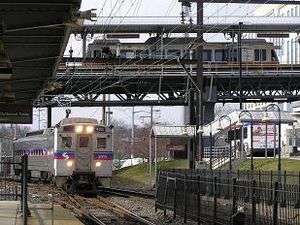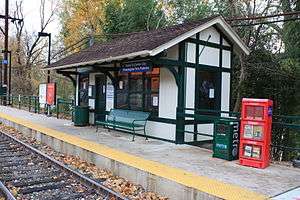Manayunk/Norristown Line
The Manayunk/Norristown Line is a commuter rail line in Southeastern Pennsylvania, and one of the 13 lines in SEPTA's Regional Rail network.
| Manayunk/Norristown Line | ||||||||||||||||||||||||||||||||||||||||||||||||||||||||||||||||||||||||||||||||||||||||||||||||||||||||||||||||||||||||||||||||||||||||||||||||||||||||||||||||||||||||||||||||||||||||||||||||||||||||||||||||||||||||||||||||||||||||||||||||||||||||||||||||||||||||||||||||||||||||||||||||||||||||||||||||||||||||||||||||||||||||||||||||||||||||||||||||||||||||||||||||||||||||||||||||||||||||||||||||||||||||||||||||||||||||||||||||||||||||||||||||||||||||||||||||||||||||||||||||||||||||||||||||||||||||||||||||||||||||||||||||||||||||||||||||||||||||||||||||||||||||||||||||||
|---|---|---|---|---|---|---|---|---|---|---|---|---|---|---|---|---|---|---|---|---|---|---|---|---|---|---|---|---|---|---|---|---|---|---|---|---|---|---|---|---|---|---|---|---|---|---|---|---|---|---|---|---|---|---|---|---|---|---|---|---|---|---|---|---|---|---|---|---|---|---|---|---|---|---|---|---|---|---|---|---|---|---|---|---|---|---|---|---|---|---|---|---|---|---|---|---|---|---|---|---|---|---|---|---|---|---|---|---|---|---|---|---|---|---|---|---|---|---|---|---|---|---|---|---|---|---|---|---|---|---|---|---|---|---|---|---|---|---|---|---|---|---|---|---|---|---|---|---|---|---|---|---|---|---|---|---|---|---|---|---|---|---|---|---|---|---|---|---|---|---|---|---|---|---|---|---|---|---|---|---|---|---|---|---|---|---|---|---|---|---|---|---|---|---|---|---|---|---|---|---|---|---|---|---|---|---|---|---|---|---|---|---|---|---|---|---|---|---|---|---|---|---|---|---|---|---|---|---|---|---|---|---|---|---|---|---|---|---|---|---|---|---|---|---|---|---|---|---|---|---|---|---|---|---|---|---|---|---|---|---|---|---|---|---|---|---|---|---|---|---|---|---|---|---|---|---|---|---|---|---|---|---|---|---|---|---|---|---|---|---|---|---|---|---|---|---|---|---|---|---|---|---|---|---|---|---|---|---|---|---|---|---|---|---|---|---|---|---|---|---|---|---|---|---|---|---|---|---|---|---|---|---|---|---|---|---|---|---|---|---|---|---|---|---|---|---|---|---|---|---|---|---|---|---|---|---|---|---|---|---|---|---|---|---|---|---|---|---|---|---|---|---|---|---|---|---|---|---|---|---|---|---|---|---|---|---|---|---|---|---|---|---|---|---|---|---|---|---|---|---|---|---|---|---|---|---|---|---|---|---|---|---|---|---|---|---|---|---|---|---|---|---|---|---|---|---|---|---|---|---|---|---|---|---|---|---|---|---|---|---|---|---|---|---|---|---|---|---|---|---|---|---|---|---|---|---|---|---|---|---|---|---|---|---|---|---|---|---|---|---|---|---|---|---|---|---|---|---|---|---|---|---|---|---|---|---|---|---|---|---|---|---|---|---|---|---|---|---|---|---|---|---|---|---|---|---|---|---|---|---|---|---|---|---|---|---|---|---|---|---|---|---|---|---|---|---|---|---|---|---|---|---|---|---|---|---|---|---|---|---|---|---|---|---|---|---|---|---|---|---|---|---|---|---|---|---|---|---|---|---|---|---|---|---|---|---|---|---|---|---|---|---|---|---|---|---|---|---|
 A Manayunk/Norristown train at Main Street station | ||||||||||||||||||||||||||||||||||||||||||||||||||||||||||||||||||||||||||||||||||||||||||||||||||||||||||||||||||||||||||||||||||||||||||||||||||||||||||||||||||||||||||||||||||||||||||||||||||||||||||||||||||||||||||||||||||||||||||||||||||||||||||||||||||||||||||||||||||||||||||||||||||||||||||||||||||||||||||||||||||||||||||||||||||||||||||||||||||||||||||||||||||||||||||||||||||||||||||||||||||||||||||||||||||||||||||||||||||||||||||||||||||||||||||||||||||||||||||||||||||||||||||||||||||||||||||||||||||||||||||||||||||||||||||||||||||||||||||||||||||||||||||||||||||
| Overview | ||||||||||||||||||||||||||||||||||||||||||||||||||||||||||||||||||||||||||||||||||||||||||||||||||||||||||||||||||||||||||||||||||||||||||||||||||||||||||||||||||||||||||||||||||||||||||||||||||||||||||||||||||||||||||||||||||||||||||||||||||||||||||||||||||||||||||||||||||||||||||||||||||||||||||||||||||||||||||||||||||||||||||||||||||||||||||||||||||||||||||||||||||||||||||||||||||||||||||||||||||||||||||||||||||||||||||||||||||||||||||||||||||||||||||||||||||||||||||||||||||||||||||||||||||||||||||||||||||||||||||||||||||||||||||||||||||||||||||||||||||||||||||||||||||
| Type | Commuter rail | |||||||||||||||||||||||||||||||||||||||||||||||||||||||||||||||||||||||||||||||||||||||||||||||||||||||||||||||||||||||||||||||||||||||||||||||||||||||||||||||||||||||||||||||||||||||||||||||||||||||||||||||||||||||||||||||||||||||||||||||||||||||||||||||||||||||||||||||||||||||||||||||||||||||||||||||||||||||||||||||||||||||||||||||||||||||||||||||||||||||||||||||||||||||||||||||||||||||||||||||||||||||||||||||||||||||||||||||||||||||||||||||||||||||||||||||||||||||||||||||||||||||||||||||||||||||||||||||||||||||||||||||||||||||||||||||||||||||||||||||||||||||||||||||||
| System | SEPTA Regional Rail | |||||||||||||||||||||||||||||||||||||||||||||||||||||||||||||||||||||||||||||||||||||||||||||||||||||||||||||||||||||||||||||||||||||||||||||||||||||||||||||||||||||||||||||||||||||||||||||||||||||||||||||||||||||||||||||||||||||||||||||||||||||||||||||||||||||||||||||||||||||||||||||||||||||||||||||||||||||||||||||||||||||||||||||||||||||||||||||||||||||||||||||||||||||||||||||||||||||||||||||||||||||||||||||||||||||||||||||||||||||||||||||||||||||||||||||||||||||||||||||||||||||||||||||||||||||||||||||||||||||||||||||||||||||||||||||||||||||||||||||||||||||||||||||||||
| Status | Operating | |||||||||||||||||||||||||||||||||||||||||||||||||||||||||||||||||||||||||||||||||||||||||||||||||||||||||||||||||||||||||||||||||||||||||||||||||||||||||||||||||||||||||||||||||||||||||||||||||||||||||||||||||||||||||||||||||||||||||||||||||||||||||||||||||||||||||||||||||||||||||||||||||||||||||||||||||||||||||||||||||||||||||||||||||||||||||||||||||||||||||||||||||||||||||||||||||||||||||||||||||||||||||||||||||||||||||||||||||||||||||||||||||||||||||||||||||||||||||||||||||||||||||||||||||||||||||||||||||||||||||||||||||||||||||||||||||||||||||||||||||||||||||||||||||
| Termini | Penn Medicine Elm Street, Norristown | |||||||||||||||||||||||||||||||||||||||||||||||||||||||||||||||||||||||||||||||||||||||||||||||||||||||||||||||||||||||||||||||||||||||||||||||||||||||||||||||||||||||||||||||||||||||||||||||||||||||||||||||||||||||||||||||||||||||||||||||||||||||||||||||||||||||||||||||||||||||||||||||||||||||||||||||||||||||||||||||||||||||||||||||||||||||||||||||||||||||||||||||||||||||||||||||||||||||||||||||||||||||||||||||||||||||||||||||||||||||||||||||||||||||||||||||||||||||||||||||||||||||||||||||||||||||||||||||||||||||||||||||||||||||||||||||||||||||||||||||||||||||||||||||||
| Stations | 16 | |||||||||||||||||||||||||||||||||||||||||||||||||||||||||||||||||||||||||||||||||||||||||||||||||||||||||||||||||||||||||||||||||||||||||||||||||||||||||||||||||||||||||||||||||||||||||||||||||||||||||||||||||||||||||||||||||||||||||||||||||||||||||||||||||||||||||||||||||||||||||||||||||||||||||||||||||||||||||||||||||||||||||||||||||||||||||||||||||||||||||||||||||||||||||||||||||||||||||||||||||||||||||||||||||||||||||||||||||||||||||||||||||||||||||||||||||||||||||||||||||||||||||||||||||||||||||||||||||||||||||||||||||||||||||||||||||||||||||||||||||||||||||||||||||
| Daily ridership | 9,839[1] | |||||||||||||||||||||||||||||||||||||||||||||||||||||||||||||||||||||||||||||||||||||||||||||||||||||||||||||||||||||||||||||||||||||||||||||||||||||||||||||||||||||||||||||||||||||||||||||||||||||||||||||||||||||||||||||||||||||||||||||||||||||||||||||||||||||||||||||||||||||||||||||||||||||||||||||||||||||||||||||||||||||||||||||||||||||||||||||||||||||||||||||||||||||||||||||||||||||||||||||||||||||||||||||||||||||||||||||||||||||||||||||||||||||||||||||||||||||||||||||||||||||||||||||||||||||||||||||||||||||||||||||||||||||||||||||||||||||||||||||||||||||||||||||||||
| Line number | Formerly R6 | |||||||||||||||||||||||||||||||||||||||||||||||||||||||||||||||||||||||||||||||||||||||||||||||||||||||||||||||||||||||||||||||||||||||||||||||||||||||||||||||||||||||||||||||||||||||||||||||||||||||||||||||||||||||||||||||||||||||||||||||||||||||||||||||||||||||||||||||||||||||||||||||||||||||||||||||||||||||||||||||||||||||||||||||||||||||||||||||||||||||||||||||||||||||||||||||||||||||||||||||||||||||||||||||||||||||||||||||||||||||||||||||||||||||||||||||||||||||||||||||||||||||||||||||||||||||||||||||||||||||||||||||||||||||||||||||||||||||||||||||||||||||||||||||||
| Website | septa.org | |||||||||||||||||||||||||||||||||||||||||||||||||||||||||||||||||||||||||||||||||||||||||||||||||||||||||||||||||||||||||||||||||||||||||||||||||||||||||||||||||||||||||||||||||||||||||||||||||||||||||||||||||||||||||||||||||||||||||||||||||||||||||||||||||||||||||||||||||||||||||||||||||||||||||||||||||||||||||||||||||||||||||||||||||||||||||||||||||||||||||||||||||||||||||||||||||||||||||||||||||||||||||||||||||||||||||||||||||||||||||||||||||||||||||||||||||||||||||||||||||||||||||||||||||||||||||||||||||||||||||||||||||||||||||||||||||||||||||||||||||||||||||||||||||
| Operation | ||||||||||||||||||||||||||||||||||||||||||||||||||||||||||||||||||||||||||||||||||||||||||||||||||||||||||||||||||||||||||||||||||||||||||||||||||||||||||||||||||||||||||||||||||||||||||||||||||||||||||||||||||||||||||||||||||||||||||||||||||||||||||||||||||||||||||||||||||||||||||||||||||||||||||||||||||||||||||||||||||||||||||||||||||||||||||||||||||||||||||||||||||||||||||||||||||||||||||||||||||||||||||||||||||||||||||||||||||||||||||||||||||||||||||||||||||||||||||||||||||||||||||||||||||||||||||||||||||||||||||||||||||||||||||||||||||||||||||||||||||||||||||||||||||
| Owner | SEPTA Regional Rail | |||||||||||||||||||||||||||||||||||||||||||||||||||||||||||||||||||||||||||||||||||||||||||||||||||||||||||||||||||||||||||||||||||||||||||||||||||||||||||||||||||||||||||||||||||||||||||||||||||||||||||||||||||||||||||||||||||||||||||||||||||||||||||||||||||||||||||||||||||||||||||||||||||||||||||||||||||||||||||||||||||||||||||||||||||||||||||||||||||||||||||||||||||||||||||||||||||||||||||||||||||||||||||||||||||||||||||||||||||||||||||||||||||||||||||||||||||||||||||||||||||||||||||||||||||||||||||||||||||||||||||||||||||||||||||||||||||||||||||||||||||||||||||||||||
| Operator(s) | SEPTA Regional Rail | |||||||||||||||||||||||||||||||||||||||||||||||||||||||||||||||||||||||||||||||||||||||||||||||||||||||||||||||||||||||||||||||||||||||||||||||||||||||||||||||||||||||||||||||||||||||||||||||||||||||||||||||||||||||||||||||||||||||||||||||||||||||||||||||||||||||||||||||||||||||||||||||||||||||||||||||||||||||||||||||||||||||||||||||||||||||||||||||||||||||||||||||||||||||||||||||||||||||||||||||||||||||||||||||||||||||||||||||||||||||||||||||||||||||||||||||||||||||||||||||||||||||||||||||||||||||||||||||||||||||||||||||||||||||||||||||||||||||||||||||||||||||||||||||||
| Rolling stock | Electric multiple units | |||||||||||||||||||||||||||||||||||||||||||||||||||||||||||||||||||||||||||||||||||||||||||||||||||||||||||||||||||||||||||||||||||||||||||||||||||||||||||||||||||||||||||||||||||||||||||||||||||||||||||||||||||||||||||||||||||||||||||||||||||||||||||||||||||||||||||||||||||||||||||||||||||||||||||||||||||||||||||||||||||||||||||||||||||||||||||||||||||||||||||||||||||||||||||||||||||||||||||||||||||||||||||||||||||||||||||||||||||||||||||||||||||||||||||||||||||||||||||||||||||||||||||||||||||||||||||||||||||||||||||||||||||||||||||||||||||||||||||||||||||||||||||||||||
| Technical | ||||||||||||||||||||||||||||||||||||||||||||||||||||||||||||||||||||||||||||||||||||||||||||||||||||||||||||||||||||||||||||||||||||||||||||||||||||||||||||||||||||||||||||||||||||||||||||||||||||||||||||||||||||||||||||||||||||||||||||||||||||||||||||||||||||||||||||||||||||||||||||||||||||||||||||||||||||||||||||||||||||||||||||||||||||||||||||||||||||||||||||||||||||||||||||||||||||||||||||||||||||||||||||||||||||||||||||||||||||||||||||||||||||||||||||||||||||||||||||||||||||||||||||||||||||||||||||||||||||||||||||||||||||||||||||||||||||||||||||||||||||||||||||||||||
| Line length | 18.1 mi (29.1 km) | |||||||||||||||||||||||||||||||||||||||||||||||||||||||||||||||||||||||||||||||||||||||||||||||||||||||||||||||||||||||||||||||||||||||||||||||||||||||||||||||||||||||||||||||||||||||||||||||||||||||||||||||||||||||||||||||||||||||||||||||||||||||||||||||||||||||||||||||||||||||||||||||||||||||||||||||||||||||||||||||||||||||||||||||||||||||||||||||||||||||||||||||||||||||||||||||||||||||||||||||||||||||||||||||||||||||||||||||||||||||||||||||||||||||||||||||||||||||||||||||||||||||||||||||||||||||||||||||||||||||||||||||||||||||||||||||||||||||||||||||||||||||||||||||||
| Track gauge | 4 ft 8 1⁄2 in (1,435 mm) standard gauge | |||||||||||||||||||||||||||||||||||||||||||||||||||||||||||||||||||||||||||||||||||||||||||||||||||||||||||||||||||||||||||||||||||||||||||||||||||||||||||||||||||||||||||||||||||||||||||||||||||||||||||||||||||||||||||||||||||||||||||||||||||||||||||||||||||||||||||||||||||||||||||||||||||||||||||||||||||||||||||||||||||||||||||||||||||||||||||||||||||||||||||||||||||||||||||||||||||||||||||||||||||||||||||||||||||||||||||||||||||||||||||||||||||||||||||||||||||||||||||||||||||||||||||||||||||||||||||||||||||||||||||||||||||||||||||||||||||||||||||||||||||||||||||||||||
| Electrification | Catenary | |||||||||||||||||||||||||||||||||||||||||||||||||||||||||||||||||||||||||||||||||||||||||||||||||||||||||||||||||||||||||||||||||||||||||||||||||||||||||||||||||||||||||||||||||||||||||||||||||||||||||||||||||||||||||||||||||||||||||||||||||||||||||||||||||||||||||||||||||||||||||||||||||||||||||||||||||||||||||||||||||||||||||||||||||||||||||||||||||||||||||||||||||||||||||||||||||||||||||||||||||||||||||||||||||||||||||||||||||||||||||||||||||||||||||||||||||||||||||||||||||||||||||||||||||||||||||||||||||||||||||||||||||||||||||||||||||||||||||||||||||||||||||||||||||
| ||||||||||||||||||||||||||||||||||||||||||||||||||||||||||||||||||||||||||||||||||||||||||||||||||||||||||||||||||||||||||||||||||||||||||||||||||||||||||||||||||||||||||||||||||||||||||||||||||||||||||||||||||||||||||||||||||||||||||||||||||||||||||||||||||||||||||||||||||||||||||||||||||||||||||||||||||||||||||||||||||||||||||||||||||||||||||||||||||||||||||||||||||||||||||||||||||||||||||||||||||||||||||||||||||||||||||||||||||||||||||||||||||||||||||||||||||||||||||||||||||||||||||||||||||||||||||||||||||||||||||||||||||||||||||||||||||||||||||||||||||||||||||||||||||
Route
The route originates from the Center City Rail tunnel, and the two-track line splits off from the "SEPTA Main Line" north of North Broad Station. It then goes through Philadelphia's East Falls and Manayunk neighborhoods and Conshohocken before reaching Norristown. At Norristown Transportation Center, commuters can transfer to regular SEPTA surface buses or the SEPTA Norristown High Speed Line to 69th Street Terminal. From Norristown Transportation Center, the electrified line follows the single track Stony Creek branch to terminate at Elm Street, while the double tracked main line continues to Reading. The Reading main west of Norristown currently carries no passenger service, and is owned and operated by the Norfolk Southern Railway as its Harrisburg Line.
As of 2019, most weekday Manayunk/Norristown Line trains terminate at 30th Street Station or continue to various destinations such as Elwyn on the Media/Elwyn Line and Marcus Hook or Wilmington on the Wilmington/Newark Line. Most weekend Manayunk/Norristown Line trains continue to Elwyn on the Media/Elwyn Line.[2]
History
The Manayunk/Norristown Line was the Reading Company's Norristown Branch from Philadelphia to Reading, Pennsylvania. Electrified service to Norristown and Chestnut Hill East began on February 5, 1933.[3] Steam (and later diesel)-operated intercity services continued to operate beyond Norristown. By the 1960s Budd Rail Diesel Cars handled most of the Reading's diesel services, although the Reading's EMD FP7 locomotives, displaced from the Crusader, saw regular use on the Philadelphia–Reading run.[4] SEPTA discontinued services beyond Norristown on July 26, 1981.[5]
Between 1984–2010 the route was designated R6 Norristown as part of SEPTA's diametrical reorganization of its lines. Manayunk/Norristown Line trains operated through the city center to the Ivy Ridge Line (later Cynwyd) on the ex-Pennsylvania side of the system.[6] The R-number naming system was dropped on July 25, 2010.[7]
Like the Cynwyd Line, the Manayunk/Norristown Line was slated to become part of the planned new Schuylkill Valley Metro, but was to serve the King of Prussia mall complex and the former Pennsylvania Railroad's Trenton Cut-Off line to Frazer, Pennsylvania. This was referred to by planners as the "Cross-County Segment." An extension of the Manayunk/Norristown Line, called the Norristown Extension, to Wyomissing was later proposed, with funding to come through new tolls on U.S. Route 422.[8][9]
Early in 2013, SEPTA began to undertake major operational improvements and physical rehabilitation on the Manayunk/Norristown Line. Central to this project is the replacement of the 80-year-old wayside automatic block signal system with one that displays only in the operating cab, and operates in both directions on both tracks, thereby allowing greater operational flexibility. Two new remotely controlled interlockings are being constructed to facilitate bidirectional operation, one at Miquon, the other in Norristown between the main station and the Ford Street crossing. An electrified storage track is also being constructed at Miquon to allow for temporary turnback of trains at that station, as the line is periodically subjected to flooding from the Schuylkill River around Spring Mill and Conshohocken. Ongoing replacement of the line's overhead catenary, most of which is 80 years old, will continue along with the signal replacement. Also occurring in conjunction with these projects are the replacement of crossties, renewal of grade crossing surfaces, and trimming of brush and trees alongside the right-of-way.[10] The entire program is scheduled for completion in fall 2015, tying in with the FRA-mandated nationwide implementation of Positive Train Control (PTC) on American railroads by the end of 2015.[11]
SEPTA activated PTC on the Manayunk/Norristown Line on August 15, 2016.[12]
As of mid-2018, the borough of Phoenixville is studying the restoration of SEPTA train service by extending the Manayunk/Norristown Line using old Reading Line track past Norristown, currently used for freight trains by Norfolk Southern.[13] In 2018, a panel led by the Greater Reading Chamber Alliance pushed for an extension of the Manayunk/Norristown Line to Reading, with service terminating either at the Franklin Street Station in Reading or in Wyomissing. The proposed extension would utilize existing Norfolk Southern freight railroad tracks. Before service can be implemented, a study would need to take place.[14]
On April 9, 2020, service on the line was suspended due to the COVID-19 pandemic,[15] though Temple University and North Broad stations were still being served by other rail services. Service resumed on June 28, 2020.[16]
Stations
The Manayunk/Norristown Line makes the following station stops after leaving the Center City Commuter Connection; stations indicated with a gray background are closed.
| Zone[17] | Location | Station | Miles (km) from Center City |
Connections / notes |
|---|---|---|---|---|
| C | Callowhill, Philadelphia | Spring Garden Street | On the former line to Reading Terminal, closed November 6, 1984[18] | |
| Temple University | Temple University |
2.1 (3.4) | SEPTA Regional Rail: all lines | |
| 1 | Glenwood, Philadelphia | North Broad |
2.9 (4.7) | SEPTA Regional Rail: Lansdale/Doylestown Line SEPTA City Transit:Broad Street Line SEPTA City Bus: 4, 16, 54 |
| Allegheny West, Philadelphia | Allegheny | 4.0 (6.4) | SEPTA City Bus: 33, 60 | |
| East Falls, Philadelphia | East Falls | 5.5 (8.9) | SEPTA City Bus: K | |
| 2 | Wissahickon, Philadelphia | Wissahickon Transportation Center | 6.4 (10.3) | SEPTA City Bus: 9, 27, 61, 62, 65 |
| Manayunk, Philadelphia | Manayunk | 7.6 (12.2) | SEPTA City Bus: 35, 61, 62 | |
| Ivy Ridge | Roxborough, Philadelphia | 8.4 (13.5) | SEPTA City Bus: 61, 62 | |
| Shawmont | 9.4 (15.1) | Closed November 10, 1996[19] | ||
| Miquon | Miquon | 10.7 (17.2) | ||
| 3 | Conshohocken | Spring Mill |
12.3 (19.8) | |
| Conshohocken | 13.5 (21.7) | SEPTA Suburban Bus: 95, 97 | ||
| Ivy Rock | 15.3 (24.6) | Closed 1983 | ||
| Mogees | 15.9 (25.6) | Discontinued on October 4, 1992[20] | ||
| Norristown | Norristown Transportation Center | 17.2 (27.7) | SEPTA Suburban Transit: Norristown High Speed Line SEPTA Suburban Bus: 90, 91, 93, 96, 97, 98, 99, 131 | |
| Main Street | 17.7 (28.5) | SEPTA Suburban Bus: 90, 91, 93, 131 | ||
| Marshall Street | 17.9 (28.8) | Closed 1959[21] | ||
| Norristown-Elm Street |
18.1 (29.1) | |||
Former diesel service
Prior to July 26, 1981, RDC diesel trains operated north of Norristown to Reading and Pottsville. Until 2011, SEPTA had considering restoring service as far as Reading as part of the Schuylkill Valley Metro project. These plans are currently on hold. The following is a list of stations formerly served by SEPTA.
| Zone | Station | Miles (km) from Reading Terminal |
Date opened | Date closed |
|---|---|---|---|---|
| 4 | Valley Forge Park | |||
| Valley Forge | 21.5 (34.6) | |||
| 5 | Phoenixville | 27.7 (44.6) | ||
| Royersford | 32.0 (51.5) | |||
| Linfield | 34.7 (55.8) | March 26, 1978[22] | ||
| 6 | Pottstown | 39.1 (62.9) | ||
| 7 | Birdsboro | 49.5 (79.7) | ||
| 8 | Reading (Franklin Street) | 58.1 (93.5) | ||
| Leesport | 66.3 (106.7) | |||
| Mohrsville | 68.6 (110.4) | |||
| Shoemakersville | 70.0 (112.7) | |||
| Hamburg | 75.3 (121.2) | |||
| 9 | Auburn | 83.5 (134.4) | ||
| 10 | Schuylkill Haven | 89.1 (143.4) | ||
| Pottsville | 93.6 (150.6) |
Ridership
Between FY 2008–FY 2018 yearly ridership on the Manayunk/Norristown Line has ranged between 2.9 million–3.1 million.[note 1]
Notes
References
- "Fiscal Year 2020 Annual Service Plan" (PDF). SEPTA. June 2019. p. 42. Retrieved December 14, 2019.
- "Manayunk/Norristown Line schedule" (PDF). SEPTA. December 16, 2018. Retrieved December 24, 2018.
- Baer, Christopher T. (April 2015). "A GENERAL CHRONOLOGY OF THE SUCCESSORS OF THE PENNSYLVANIA RAILROAD COMPANY AND THEIR HISTORICAL CONTEXT: 1933" (PDF). Pennsylvania Railroad Technical and Historical Society.
- Woodland, Dale W. (December 2003). "SEPTA's Diesels". Railpace Newsmagazine. pp. 21–22.
- Williams, Gerry (1998). Trains, Trolleys & Transit: A Guide to Philadelphia Area Rail Transit. Piscataway, New Jersey: Railpace Company. p. 47. ISBN 978-0-9621541-7-1.
- Vuchic, Vukan; Kikuchi, Shinya (1984). General Operations Plan for the SEPTA Regional High Speed System. Philadelphia: SEPTA. pp. 2–8.
- Lustig, David (November 2010). "SEPTA makeover". Trains Magazine. Kalmbach Publishing: 26.
- Hambright, Brett (December 12, 2010). "Decision near on Route 422 tolls". Reading Eagle. Retrieved December 12, 2010.
- Hambright, Brett (August 10, 2010). "Technology is making tolls (almost) painless". Reading Eagle. Retrieved December 12, 2010.
- "Manayunk/Norristown Line Shuttle Busing: An Explanation". SEPTA. Retrieved 18 March 2013.
- "SEPTA's Capital Program:Regional Rail Signal System Modernization Program" (PDF). Fiscal Year 2014 Capital Budget Proposal. Southeastern Pennsylvania Transportation Authority. Archived from the original (PDF) on 11 April 2013. Retrieved 29 March 2013.
- "Positive Train Control Update". SEPTA. May 1, 2017. Retrieved May 17, 2017.
- "Phoenixville Regional Rail Plan Moving Forward". Patch. May 9, 2018. Retrieved June 20, 2018.
- Brelje, Beth (August 21, 2018). "Panel hopes to revive Reading to Norristown passenger train service". Reading Eagle. Retrieved August 26, 2018.
- "Service Information". SEPTA. Retrieved April 14, 2020.
- "SEPTA Regional Rail & Rail Transit Lifeline Service" (PDF). SEPTA. 2020. Retrieved April 14, 2020.
- "Manayunk/Norristown Line Timetable" (PDF). Philadelphia, Pennsylvania: Southeastern Pennsylvania Transportation Authority. September 10, 2017. Retrieved October 19, 2017.
- Williams, Edgar (November 6, 1984). "A Fond Adieu to Reading Terminal". The Philadelphia Inquirer. pp. A1, A8. Retrieved July 4, 2019 – via Newspapers.com.

- Dougherty, Frank (October 25, 1996). "Septa Board Cuts Service But Oppostion Is Spirited". The Philadelphia Inquirer. Retrieved October 25, 2017.
- "New Rail Schedules Set". The Philadelphia Inquirer. Philadelphia, Pennsylvania. October 2, 1992. p. 36. Retrieved October 19, 2017 – via Newspapers.com.

- "To Make Changes". The Scranton Tribune. September 16, 1959. p. 1. Retrieved July 4, 2019 – via Newspapers.com.

- "Rail Hikes Stalled". The Philadelphia Daily News. March 23, 1978. p. 62. Retrieved October 26, 2017 – via Newspapers.com.

- "Fiscal Year 2019 Annual Service Plan" (PDF). SEPTA. June 2018. p. 74. Retrieved December 14, 2019.
- "Fiscal Year 2018 Annual Service Plan" (PDF). SEPTA. June 2017. p. 44. Retrieved December 14, 2019.
- "Fiscal Year 2017 Annual Service Plan" (PDF). SEPTA. October 2016. p. 70. Retrieved December 14, 2019.
- "Fiscal Year 2016 Annual Service Plan" (PDF). SEPTA. June 2015. p. 94. Retrieved December 14, 2019.
- "Fiscal Year 2015 Annual Service Plan" (PDF). SEPTA. May 2014. p. 60. Retrieved December 14, 2019.
- "Fiscal Year 2014 Annual Service Plan" (PDF). SEPTA. May 2013. p. 44. Retrieved December 14, 2019.
- "Fiscal Year 2013 Annual Service Plan" (PDF). SEPTA. May 2012. p. 55. Retrieved December 14, 2019.
- "Fiscal Year 2012 Annual Service Plan" (PDF). SEPTA. July 2011. p. 94. Retrieved December 14, 2019.
- "Fiscal Year 2011 Annual Service Plan" (PDF). SEPTA. June 2010. p. 70. Retrieved December 14, 2019.
- "Fiscal Year 2010 Annual Service Plan" (PDF). SEPTA. June 2009. p. 63. Retrieved December 14, 2019.

